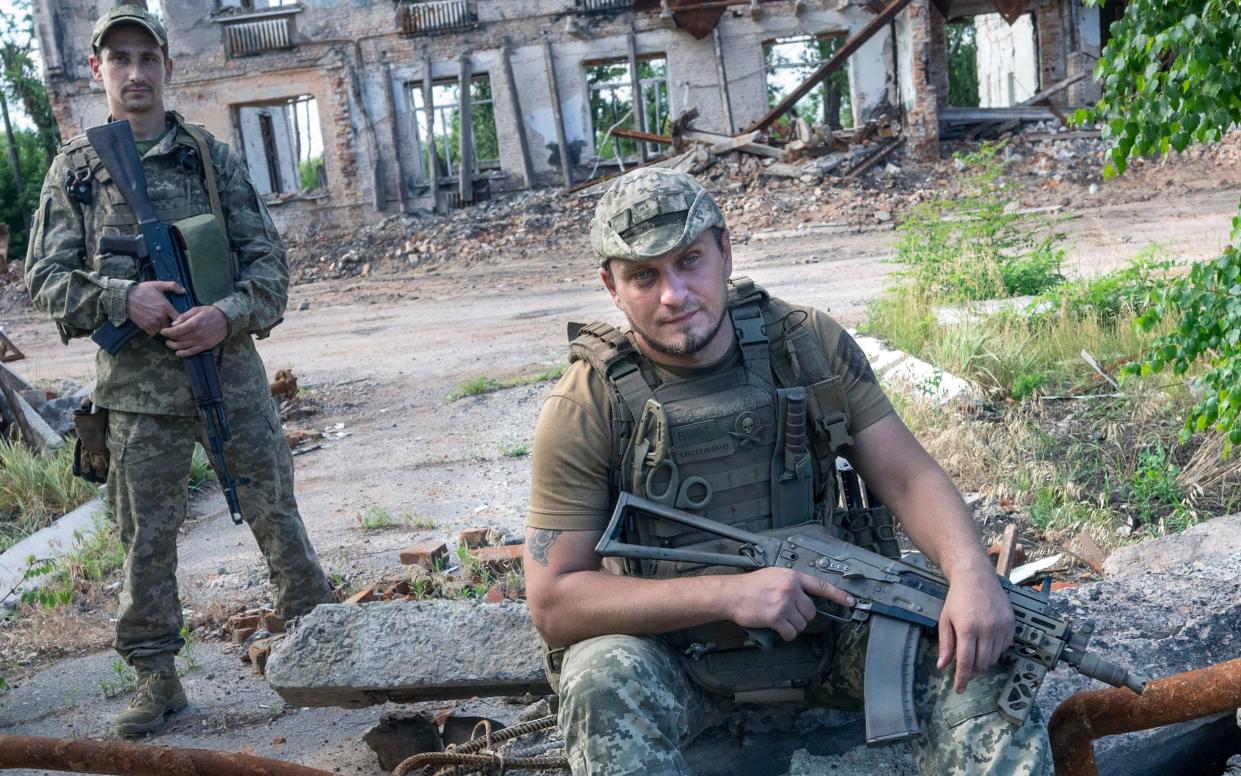Listen: The terrifying sounds of modern warfare in Ukraine

Soldiers near the front quickly learn to tell the drones apart by their sound alone.
There is the ominous buzz of the tiny reconnaissance drones.
Then there are bigger drones with a payload of grenades or bombs to drop, which sound heavier.
Most alarming of all are the first-person view (FPV) kamikaze drones, which are guided down to smash into their targets and detonate. Some soldiers say these can make a kind of whistling sound as they swoop down.
Remote-controlled drones are now so commonly used on both sides nearly two-and-a-half years into the Ukraine war and are so all-pervasive on the front that every soldier subconsciously listens out for the telltale sounds.
The precaution is constant and quickly becomes instinctive.
“It’s not like we are scared when we hear them, we know what to do,” says one soldier serving with the Ukraine 43rd Brigade and using the callsign “Primak”.
“When it’s on open ground, we move as fast as possible, so it’s less dangerous.”
The drone menace is a daily threat to the soldiers along this part of the front and elsewhere.
A company master sergeant, who has the callsign “Barman” because of his pre-war job, reels off his close escapes.
“Once a kamikaze drone hit the ground only 3m from me.
“Other times they have dropped grenades 15 to 20m from me.”
The menace extends well beyond the front line. Later in the day, we came across the eerie sight of a bus abandoned across a deserted road junction.
The Kharkiv-to-Kupiansk service had its windscreen and front tyres blown out and broken glass and debris littered the road. A blast mark was visible on the road 50 yards further up the road from where the bus had ground to a halt on its deflated tyres.
Police said only five minutes earlier a Russian kamikaze drone had struck the road next to the bus, sending it slewing to a halt. Fortunately, no one was hurt, but the attack was perhaps 10 miles behind the front line.
The war in Ukraine has been characterised by drone deployment of an unprecedented scale. Every day, each side uses hundreds of unmanned aerial vehicles (UAVs) to track enemy forces, guide artillery and strike targets.
While the craft have been used in conflicts before, Russia’s invasion has taken their use to a new level.
Drone units from both sides publish daily videos demonstrating how drones costing as little as £400 can destroy costly artillery pieces or tanks worth millions.
What began as ad hoc use by units has quickly changed to become highly organised, with drones integrated into Ukraine’s armed forces structure. Almost every fighting brigade has an assault drone company, while most units have small reconnaissance drones.
Ukraine is thought to be leading the drone race, in both numbers and innovation, driven partly by its need to compensate for Russia’s huge artillery superiority.
Swarms of kamikaze drones were partly credited with blunting Russia’s renewed offensive into Kharkiv last month.
Ukraine has said it wants to manufacture a million FPV drones this year, nearly the same number of artillery shells its US and European backers are expected to make.
‘Kamikaze drones hit every day’
But Russia is also heavily investing in the weapons and Ukrainian infantrymen cite FPV kamikaze drones and others that drop munitions as among their biggest threats.
“Kamikaze drones hit every day,” said one soldier with the 43rd Brigade.
High above the battlefield there are also higher-altitude Russian reconnaissance drones that are difficult to stop.
The drone war has given rise to a shadow electronic warfare contest. Each side tries to jam, scramble and disable the enemy drones, while all the time trying to defeat similar measures by their opponent.
This time last year, Ukraine was estimated to be losing 10,000 drones per month to Russian counter measures such as electronic warfare.
Russia has also been putting up drone fences and nets around targets to try to stop swarms getting through.
Armoured vehicles such as tanks also increasingly employ bulky “turtle shells” of steel plate and slat armour to cover the vehicle and provide a shield against drone attacks.
Both sides are reported to have experimented with deploying acoustic sensors to detect drones. Ukraine is said to have had success using the technique to detect longer-range Iranian drones used on targets hundreds of miles behind the front.
‘Busiest battlefield in Ukraine’
Russian forces held Kupiansk, a strategic rail hub, for six months in 2022. Ever since, there has been heavy fighting to the east of the city.
Military analysts say Russian forces are pushing towards Kupiansk as they try to capture the remainder of the Luhansk region and push westward into Kharkiv and northern Donetsk. The front has moved little but, in recent weeks, Ukrainian forces have said it has at times been the busiest battlefield in the country.
Soldiers of the 43rd Brigade said the front lines had changed little since they arrived in the area late last year, but the Russian forces were constantly trying to break through.
“Barman”, who served with the army from 2016 to 2020 before joining up again at the start of the full-scale invasion, said: “The front isn’t changing much, but I could describe the situation as ‘heavy’.
“Lots of artillery, aviation, mortars, glide bombs, drones and infantry.”
The brigade’s area had been hit by 15 glide bombs, which are released from aircraft at a distance well beyond air defences, that day alone.
He said the biggest threat his troops faced at the moment came from Russian rocket launchers like the Grad, Smerch and Hurricane systems.
He added: “They have a lot of those and a lot of different shells, including cluster bombs.”
‘The Russians have enough shells’
“Primak” said he had joined the army last year, having previously been a miner in Kryvyi Rih.
Since he arrived on the Kupiansk front, his battalion had been holding the same positions.
“A couple of times we had attacks and the Russians were within 100m or 150m. Most of the time we are being hit by mortars or kamikaze drones.
“We are shelled every day. They have enough shells to do it every day.
“Our biggest problem is that the Russians have many more troops than us and many more shells.”
The ammunition shortages caused by political hold-ups of US military aid had affected the brigade, soldiers admitted. Supplies had yet to resume, despite Washington now having reached an agreement to unblock aid.
New weapons and ammunition have been trickling to the front line since president Joe Biden signed off on the massive aid package in April. But it will take weeks, if not months, for Ukraine to fully replenish its depleted stocks.
But “Primak” said he was still in good spirits.
He said: “I still have good morale. I am still strong. My motivation is my kids who are living in Kryvyi Rih.”


 Yahoo News
Yahoo News 
